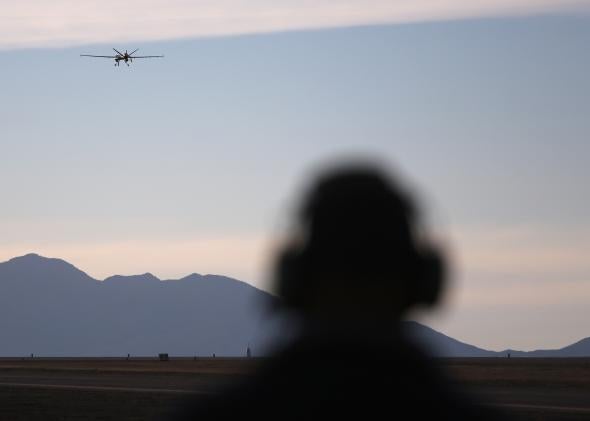The FBI believes that warrantless drone surveillance is constitutionally permissible—hardly a surprise from an agency that has spent $3 million dollars on drones since 2006. But in drawing this conclusion, the FBI relies on case law that supports warrantless aerial surveillance from manned aircraft, not unmanned aircraft. Is this a distinction that might make a difference?
Perhaps. True, there’s no authoritative case law on unmanned aerial surveillance quite yet. But the cases cited by the FBI (in a slideshow acquired by Citizens for Ethics and Responsibility in Washington through a Freedom of Information Act request) contain clues that could distinguish drone surveillance from its manned predecessors.
For example, in California v. Ciraolo (1986), the Supreme Court upheld the warrantless aerial surveillance of an individual’s marijuana garden, located in his backyard and protected from ground-level view by tall fences. The Supreme Court reasoned that “any member of the public flying in this airspace who glanced down could have seen everything that these officers observed,” and found that the Fourth Amendment did not require a warrant for what was “visible to the naked eye.” This logic explicitly turns on what humans—and here, any human—would be able to see. Florida v. Riley (1989), also cited by the FBI, involves this same type of “naked eye” observation.
But a surveillance drone—which would of course be camera-equipped—differs greatly from a naked eye. For one thing, the drone can record and store imagery with permanence and accuracy far beyond what the human memory would offer. This storage allows for in-depth and detailed analysis, both at the time of collection and far in the future. And as my colleagues and I have argued elsewhere, when “machines are watching” (that is, when tracking is automated), the potential for abuse grows greater.
The FBI also relies on Dow Chemical Co. v. United States (1986) to conclude “the use of aerial observation and photography by government agencies is permitted without a warrant.” That’s true, given the facts of Dow, but the court also noted that the photographs in that case were “not so revealing of intimate details as to raise constitutional concerns.” Moreover, that analysis considered the expectation of privacy for a commercial industrial complex, which is certainly less private than a home. The court also noted the difference between a specialized camera and a “conventional, albeit precise commercial camera commonly used” elsewhere. These could all indicate limits on how surveillance drones may be used.
Bizarrely—or perhaps optimistically—the FBI slides seem to find support in the recent GPS tracking case, United States v. Jones. In Jones, five of the justices—that is, the four members of the Justice Alito concurrence, along with Justice Sotomayor—plainly concluded that long-term monitoring would violate one’s reasonable expectation of privacy. While none of them explicitly concluded that this would require a warrant, their logic strongly suggests it. Yet the slides proclaim that the “good part” of Jones is that “All Justices endorse continued use of airborne surveillance without a warrant.” It’s not clear how they reach this conclusion, since no part of that outcome appears to support “continued” airborne surveillance.
The FBI does get it right, however, when it cites Kyllo v. United States to point out that “one can go too far” with surveillance. In Kyllo, the court required a warrant for the use of thermal imaging technology—and in doing so, exhibited its discomfort with technology that showed vast potential for abuse. Advanced forms of that heat-seeking technology, when used without a warrant, would almost certainly “shrink the realm of guaranteed privacy.” As a result, the court advocated “tak[ing] account of more sophisticated systems that are already in use or in development.”
Hopefully, the FBI will heed the court’s warning. Law enforcement drones could easily be equipped with facial recognition technology or infrared sensors—precisely the type of add-ons that would unquestionably prompt Fourth Amendment concerns in light of Kyllo.
The truth is that we won’t know exactly how precedent from the 1980s will apply to this new technology until courts take a crack at it. What we can count on, however, is a looming clash: while a number of states seek to limit law enforcement use of drones, the FBI slides exhibit little hesitation in plowing forward with drone use anyway. (And they are just one of nineteen law enforcement agencies permitted to do so.) We’ll just have to wait and see whether courts will limit the law enforcement use of drones as an example of “too permeating police surveillance.”
